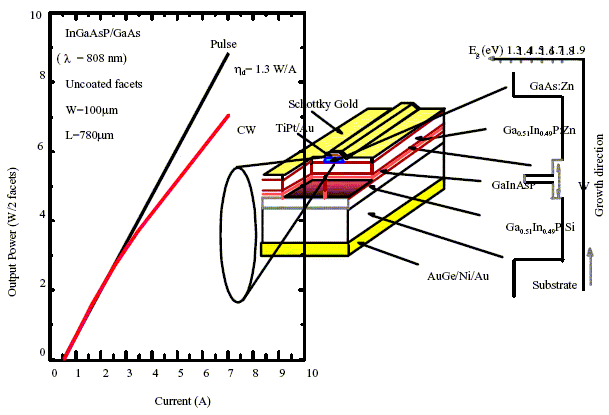

| Aluminum-Free InGaAsP/GaAs Lasers Emitting at 980 nm and 808 nm
High Power Aluminum-Free LasersResearchers at the Center for Quantum Devices have investigated the use of InGaAsP/GaAs separate confinement heterostructures as an alternative to existing technology and have demonstrated reliable high power lasers emitting from 700 nm up to 1000 nm which can be used in a wide range of applications including optical pumping of Nd:YAG or Er-doped crystal lasers, frequency doubling for blue and green light emission, and laser surgery. The technology has been patented and licenced to Semiconductor Laser International Corporation.   High power InGaAsP laser diodes offer an excellent solution for the miniature high efficiency optical pumping of solid state laser crystals. Because they do not contain aluminum (thus called "aluminum-free"), these laser diodes outperform in many aspects current commercially produced laser diodes which are based on Al-GaAs (aluminum-gallium-arsenide) semiconductor materials. These AlGaAs lasers are inherently unable to meet all the stringent requirements imposed by modern applications. For instance, aluminum oxidizes very easily during laser fabrication and high power operation. Structural defects can spread through the laser diode more easily, thus forming light-absorbing clusters (dark lines and dark spots) and leading to laser degradation. High Power InGaAsP/GaAs 980 nm LasersThe Al-free InGaAs/GaAs/InGaP ~980 nm lasers grown by metal-organic chemical-vapor deposition demonstrated excellent performances for high power at more than 6 and 3.5 W, respectively, both in continuous wave operation with un-coated mirror facets. In our work, we study the physical origins for optical losses of the InGaAs/GaAs/InGaP ~ 980 nm lasers.  The aluminum-free technology was used to achieve high performance semiconductor lasers emitting at 980 nm. These lasers exhibited a low Jth ~ 70 A/cm², high differential efficiency ~1.0 W/A, and low internal loss of 1.5 cm-1. They also yielded high output power and a very high characteristics temperature T0, over 350K in the range of 20-40 C. These 980 nm lasers could operate under continuous wave at high power (1.4 W) at 100 °C. High Power InGaAsP/GaAs 808 nm LasersInGaAsP/GaAs-based lasers, grown by metalorganic chemical vapor deposition (MOCVD) have been shown to have similar reliability as the InGaAsP/InP system. With perfect lattice matching of the quaternary InGaAsP to the substrates, suppression of dark line defects and dark spot defects, and the high catastrophic optical damage (COD) power limit have been reported in InGaAsP/GaAs when compared to the Al-based AlGaAs material system for the similar wavelengths. 
Schematic of the design and typical current-vs-light output curves for 808 nm lasers. However, so far the possible advantages of Al-free lasers in long-term reliability have not been directly substantiated by lifetime testing of the devices at high temperature. More importantly, it is commonly observed that sudden failures of devices occur during lifetime testing without any warning of failure. 
Degradation was not observed for more than 30,000 hours. In this work, we report the first long-term reliability of the Alfree lasers. Lifetime testing was performed on several uncoated lasers randomly selected from a single wafer, at high-power ~1 W, high-temperature ~60 °C operation. For over 30,000 hours of operation, none of the lasers showed any noticeable degradation in threshold current, efficiency, or emission wavelengths. Several device characteristics of these lasers related to the long-term reliability are discussed in this work. 
Highest wall plug efficiency (66 %) for CQD�s 808 nm lasers. The record wall plug efficiency of 66 % was achieved for these lasers. 
Quasi-cw output powers in excess of 70 watts for array of lasers. Optimized 808 nm laser diodes with uncoated facets emitted high output powers of 10 W and 7 W in pulse and continuous wave operation, respectively. Laser bars yielded output powers of 70 W in quasi-continuous wave operation. A properly designed InGaAsP laser structure provides anarrow transverse beam with a divergence of only 26°, which is convenient for efficient laser light coupling into the optical fiber or the pumped Nd:YAG crystal. For comparison, 32-48° are typical values of beam divergence for commercial AlGaAs lasers. last updated 1/31/2007 |
| © 2020 Center for Quantum Devices, Northwestern University Disclaimer |